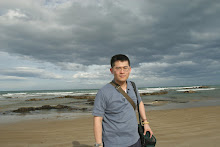Cadillac Gorge in Gippsland is a place of singular beauty, best revealed in its fullness when the tide runs high. Unlike many locations along the coast near Melbourne, which lose much of their drama to the receding waters, this gorge gains its splendour precisely at the hour when the sea presses inward, filling its chasms with heaving, silvered tides. It was during the quiet severity of winter that this particular scene was captured, when the air was sharp, the sea restless, and the light cast a subdued, almost austere glow across the stone.
The natural history of the gorge is deeply rooted in the geological character of Gippsland’s coast. Over countless millennia, waves and weather chiselled away at the softer rock, leaving behind a rugged cleft where the sea now surges and withdraws in eternal rhythm. The walls of the gorge bear silent testimony to this slow labour of time, their strata marking ancient epochs of earth and ocean. In winter, sea-spray often wreathes the rocks in a fine mist, and birdlife—gulls, cormorants, and the occasional sea eagle—can be seen circling above, drawn by the bounty of the waters.
The human history of Cadillac Gorge, though quieter, is no less meaningful. Long before European settlement, the coastal country of Gippsland was part of the traditional lands of the Gunai/Kurnai people, for whom the shorelines and sea caves were places of food gathering, story, and spiritual connection. With colonisation, the coast became a frontier for sealing, fishing, and later, tourism, as travellers from Melbourne sought out wild beauty beyond the city. Today, though relatively little known compared with the more frequented coves of Phillip Island or the Great Ocean Road, Cadillac Gorge stands as one of those hidden places that rewards patient discovery.
Thus, a photograph taken here at high tide is not merely an image of rocks and water: it is a moment within a much older story, shaped by the forces of earth and sea, and framed by the layered presence of human history upon the land.
Sony A7RV
FE 16-35mm f2.8 GM
Linking Skywatch Friday



































